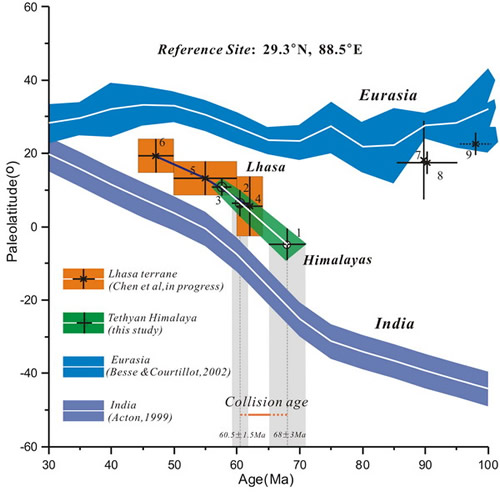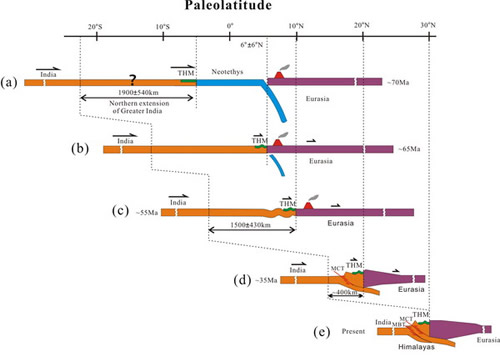Paleomagnetism of early Paleogene marine sediments in southern TibetUpdate time:08 30, 2011
Ph.D student YI Zhiyu and his teacher HUANG Baochun report a paleomagnetic study of Paleocene marine sediments in the Gamba area of the Tethyan Himalayan terrane, southern Tibet, which aims to accurately locate the position of the northern margin of Greater India and further constrain timing of initial contact between India and Asia. Following detailed rock magnetic and paleomagnetic experiments on a total of 675 drill-core samples collected from the Zongpu and Upper Jidula formations, characteristic remanent magnetizations (ChRMs) were successfully isolated from most samples following alternating field (AF) or integrated thermal and AF demagnetization. The results also indicate that at least 1500±480 km of post-collisional crustal shortening occurred within the Himalayas. From the analysis of available paleomagnetic data obtained on both sides of the suture zone, we propose a conceptional collision model for the India–Asia collision. Zhiyu Yi, Baochun Huang, Junshan Chen, et al. Paleomagnetism of early Paleogene marine sediments in southern Tibet, China: Implications to onset of the India-Asia collision and size of Greater India. Earth and Planetary Science Letters, 2011, 309: 153-165 (Download Here)
Fig. 1. Paleolatitudinal comparison within India, Eurasia, Himalayas, and Lhasa during post-late Cretaceous times. (Image by YI Zhiyu)
Fig. 2. Conceptional model describing geodynamic evolution of the India–Asia collision in post-late Cretaceous times (approximately a S–N profile). (Image by YI Zhiyu)
|
Contact
Related Articles
Reference
|
-
SIMSSecondary Ion Mass Spectrometer Laboratory
-
MC-ICPMSMultiple-collector ICPMS Laboratory
-
EM & TEMElectron Microprobe and Transmission Electron Microscope Laboratory
-
SISolid Isotope Laboratory
-
StIStable Isotope Laboratory
-
RMPARock-Mineral Preparation and Analysis
-
AAH40Ar/39Ar & (U-Th)/He Laboratory
-
EMLElectron Microscopy Laboratory
-
USCLUranium Series Chronology Laboratory
-
SASeismic Array Laboratory
-
SEELaboratory of Space Environment Exploration Laboratory
-
PGPaleomagnetism and Geochronology Laboratory
-
BioMNSFrance-China Bio-mineralization and Nano-structure Laboratory

 Print
Print Close
Close

